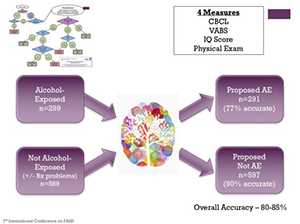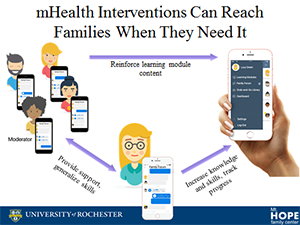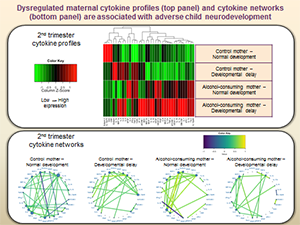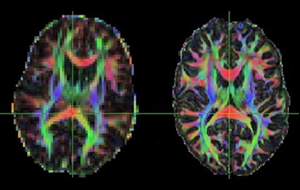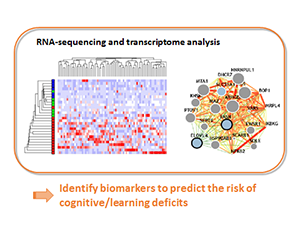Research Projects and Components
- Administration of CIFASD (Edward P. Riley, PI)
- Prenatal alcohol effects on physical development (Kenneth L. Jones, PI)
- Early predictors of FASD (Christina Chambers, PI)
- FASD in adults: Health and behavior (Claire D. Coles, PI)
- Genetic contributions to FASD (Tatiana Foroud, PI)
- Prenatal alcohol effects on facial development (Alison Noble and Michael Suttie, PIs)
- Development of screening tools to identify FASD (Sarah N. Mattson Weller, PI)
- Genetics risk factors of FASD (Scott Parnell and Johann Eberhart, PIs)
- Mobile caregiver intervention for FASD (Christie L. McGee Petrenko and Cristiano Tapparello, PIs)
- Mobile Health Tools to Promote Health in Adults With FASD (Christie L. McGee Petrenko and Cristiano Tapparello, PIs)
- Choline Polymorphisms in FASD (Susan M. Smith, PI)
- Biomarkers in children with FASD that predict neurobehavioral performance (Annika Montag and Christine Austin, PIs)
- Immune dysregulation in FASD (Joanne Weinberg, PI)
- Brain connectivity in FASD (Jeffrey R. Wozniak, PI)
- Prenatal alcohol effects on the gut microbiome (Thomas G. Blanchard, PI)
- Biomarkers for FASD (Kazue Hasimoto-Torii and Masaaki Torii, PIs)
Administration of CIFASD
 This project brings experts together to better understand how prenatal alcohol affects the developing baby, so that we can better treat and prevent fetal alcohol spectrum disorders (FASD). Our goals are to better identify individuals who have been exposed to alcohol prenatally, to determine factors that increase or reduce risk to FASD, to understand the effects of prenatal alcohol exposure across the lifespan, and to develop treatments for FASD. We will begin to use new mobile eHealth approaches to better achieve these goals.
This project brings experts together to better understand how prenatal alcohol affects the developing baby, so that we can better treat and prevent fetal alcohol spectrum disorders (FASD). Our goals are to better identify individuals who have been exposed to alcohol prenatally, to determine factors that increase or reduce risk to FASD, to understand the effects of prenatal alcohol exposure across the lifespan, and to develop treatments for FASD. We will begin to use new mobile eHealth approaches to better achieve these goals.
Edward P. Riley, Principal Investigator
Administrative Core of the CIFASD U24AA014811-14 | San Diego State University
The Collaborative Initiative on Fetal Alcohol Spectrum Disorders (CIFASD) is a multidisciplinary, international consortium of research projects and resource cores charged with improving prevention, diagnosis, and treatment of FASD. The Administrative Resource Core of the CIFASD has led this consortium since it was first established in 2003 and plays a critical leadership role in the coordination of research efforts and ensuring progress toward consortium goals. CIFASD addresses issues related to prenatal alcohol exposure across the lifespan, using a range of interrelated clinical and preclinical research approaches. One goal of the CIFASD is to improve identification of individuals who have been affected by prenatal alcohol exposure. This will be accomplished by assessing biomarkers, such as immune and miRNA profiles, and by using neuroimaging techniques that may be more sensitive to subtle pathology seen in individuals who do not meet the diagnostic criteria for FAS. In addition, CIFASD will develop novel tools, such as 3D facial and neurobehavioral screening, which can be assessed remotely and made more universally accessible through eHealth. The use of telemedicine will also provide access to more detailed dysmorphology evaluations. Another goal is to identify risk and resiliency factors, including genetic influences that will help with understanding the mechanisms of alcohol’s damaging effects and also lead to more targeted interventions. A third goal is to better understand the effects of prenatal alcohol exposure on consequences across the lifespan, including adulthood. Finally, an intervention for improving outcomes will be modified to a mobile platform, so that it can reach larger populations of individuals with FASD and their families. Collectively, these projects have the potential for moving the FASD field forward, improving the prevention, diagnosis, and treatment of FASD and serving a wide audience with the technologies available in eHealth. The Specific Aims of the Administrative Core are to: 1) Provide scientific and administrative direction, leadership and oversight to CIFASD; 2) Facilitate communication among the various projects and the dissemination of results; 3) Assist with data management strategies; 4) Provide annual evaluations of progress; and 5) Provide assistance to projects with implementing eHealth technology. The Administrative Core provides the foundation for the interactive and supportive framework of CIFASD by establishing regular communications with all members through monthly conference calls and biannual meetings; leading the Steering Committee in the establishment and implementation of CIFASD priorities and policies; supporting the Science Advisory Board with its evaluations of progress on each component as well as the overall mission of CIFASD; as well as serving as the liaison between the consortium’s project scientists and its NIAAA advisors.
The consequences resulting from prenatal alcohol exposure are wide-ranging and a major and costly public health problem. The goal of the CIFASD consortium is to enhance the identification and treatment of FASD utilizing a multidisciplinary approach consisting of both basic science and clinical research. The collaborations among research projects will allow CIFASD to improve the diagnosis and treatment of FASD, moving the field forward in ways that could not be easily achieved by individual projects.
Prenatal alcohol effects on physical development
 Many things can affect development of a child, including prenatal exposure to alcohol. Getting a diagnosis of FASD can be a major challenge for families. Although there are no lab tests that can diagnosis FASD, there are a number of subtle physical features that may help us identify kids with FASD. Our group helps CIFASD detect children with FASD, trains more doctors and health care professionals who do not have the experience to diagnose FASD, and is developing telemedicine systems to help identify FASD, especially in low income, underserved areas of the U.S. Our goal is to develop ways to improve diagnosis and help individuals and their families who may not otherwise have access to physicians with FASD expertise.
Many things can affect development of a child, including prenatal exposure to alcohol. Getting a diagnosis of FASD can be a major challenge for families. Although there are no lab tests that can diagnosis FASD, there are a number of subtle physical features that may help us identify kids with FASD. Our group helps CIFASD detect children with FASD, trains more doctors and health care professionals who do not have the experience to diagnose FASD, and is developing telemedicine systems to help identify FASD, especially in low income, underserved areas of the U.S. Our goal is to develop ways to improve diagnosis and help individuals and their families who may not otherwise have access to physicians with FASD expertise.
Kenneth L. Jones
Dysmorphology Research Resource U24AA014815-14 | University of California San Diego
The specific aims of the Dysmorphology Research Resource are to use the previously established CIFASD physical examination protocol and classification system to perform and/or validate physical examinations of all infants, children and adults who are participants in the CIFASD renewal project, to provide on-going training and re-training of local pediatricians/neonatologists/geneticists who are providing preliminary examinations at some CIFASD sites and to further develop and refine a telemedicine program developed in the last funding period. The overall goals of the Dysmorphology Research Resource is to 1) assure consistency as well as accuracy in recognition of Fetal Alcohol Spectrum Disorders (FASDs) at all CIFASD project sites where new subjects are being recruited 2) provide, through the telemedicine program, an added source of research subjects resulting in a partial solution to the problems created by the lack of adequate numbers of research subjects with a diagnosis of an FASD, 3) train additional physicians and health care providers, particularly those in low income, underserved areas of the United States, in the diagnosis of FASDs, and 4) through the telemedicine program, reach underserved areas that lack physicians with expertise in clinical recognition of FASDs. In that all children will be evaluated using a standard protocol by one of two physicians with expertise in recognition of features characteristic of prenatal alcohol exposure dramatically increases the integrity of conclusions that can be drawn regarding the overall aims of the CIFASD Consortium. The outcomes of all clinical studies completed through the Consortium will be totally dependent on these evaluations, either face-to-face or through telemedicine, by the Dysmorphology Research Resource.
Fetal Alcohol Spectrum Disorders are one of the most common brain-based disorders occurring with a prevalence of approximately 3% to 4% of the general population. Evaluation of children using a standard protocol by one of two physicians in the Dysmorphology Research Resource with expertise in recognition of features characteristic of prenatal alcohol exposure dramatically increases the integrity of conclusions that can be drawn regarding the overall aims of the CIFASD Consortium. By using telemedicine and face-to-face examinations the Dysmorphology Research Resource will identify effected individuals in all consortium sites, including remote, medically underserved areas in Minnesota and New Mexico, which will provide them access to effective intervention programs.
Early predictors of FASD
 Early identification of children with FASD is a challenge, and opportunities for early intervention are missed. We have detailed information on prenatal alcohol exposure and FASD outcomes, and have collected biological samples from mothers and children. We are now investigating a panel of biological markers for screening pregnant women and infants for signs of FASD in pregnancy and during infancy/early childhood, including markers in the mothers’ blood during pregnancy that are linked to FASD outcomes in their children. We are working to develop new, low-cost and more efficient methods for screening infants and young children for FASD. We are also using our data from the last 10 years to develop a clinical tool that can help predict their future development. This tool will help clinicians and families more effectively target treatments for children with prenatal alcohol exposure.
Early identification of children with FASD is a challenge, and opportunities for early intervention are missed. We have detailed information on prenatal alcohol exposure and FASD outcomes, and have collected biological samples from mothers and children. We are now investigating a panel of biological markers for screening pregnant women and infants for signs of FASD in pregnancy and during infancy/early childhood, including markers in the mothers’ blood during pregnancy that are linked to FASD outcomes in their children. We are working to develop new, low-cost and more efficient methods for screening infants and young children for FASD. We are also using our data from the last 10 years to develop a clinical tool that can help predict their future development. This tool will help clinicians and families more effectively target treatments for children with prenatal alcohol exposure.
Christina Chambers
Early Predictors of FASD in Ukraine U01AA014835-14 | University of California San Diego
Accurate diagnosis and early identification of infants or children with Fetal Alcohol Spectrum Disorders (FASD) is essential to initiating early intervention leading to improved outcomes for affected children. However, children with FASD are most often not diagnosed until many years after birth. As a result, many years of appropriate and beneficial intervention or treatment are missed. Given the high prevalence of FASD in areas of the world where the disorder has been studied, earlier and more accurate recognition of children with FASD is of high public health importance. Building on the existing Collaborative Initiative on Fetal Alcohol Spectrum Disorders (CIFASD) longitudinal cohort study in Ukraine, we aim to fill this critical gap in knowledge in two ways. First, we will develop a panel of three prenatal/early infancy biomarkers that can predict FASD. These biomarkers include maternal and infant microRNA expression profile, maternal and infant cytokine expression profile, and an early infancy measure of neurobehavioral performance. Second, we will develop risk/resilience prediction models based on the developmental trajectories of children enrolled in the cohort. These models will identify the characteristics of a prenatally exposed infant/child at a given age that are predictive of the child’s later growth and performance. This work will support earlier identification of affected children and can help to determine appropriate early allocation of resources for intervention and treatment to those children most likely to benefit. Furthermore, our findings may suggest novel approaches to biological and environmental targets for treatment and intervention. We will also work collaboratively with other investigators in the CIFASD Consortium to interactively address the overall goals of the Consortium in improving diagnosis and treatment of FASD.
Accurate and early identification of infants with Fetal Alcohol Spectrum Disorders (FASD) is essential to initiating early intervention for those children; however, most children with FASD are not recognized until long after infancy. This study will develop a panel of biomarker tests along with a clinical prediction tool that can help improve our ability to identify children with FASD in infancy so they can obtain optimum benefit from early intervention.
FASD in adults: Health and behavior
 Although there have been many studies of children with FASD, we know very little of adults with FASD. We will study the long-term effects of prenatal alcohol exposure on health, social and cognitive functioning. Specifically, this study will determine how fetal alcohol exposure affects immune function, as well as physical and mental health in adults. We hope that this information will help us improve screening for FASD among health care providers and improve diagnosis of FASD in this age group.
Although there have been many studies of children with FASD, we know very little of adults with FASD. We will study the long-term effects of prenatal alcohol exposure on health, social and cognitive functioning. Specifically, this study will determine how fetal alcohol exposure affects immune function, as well as physical and mental health in adults. We hope that this information will help us improve screening for FASD among health care providers and improve diagnosis of FASD in this age group.
Claire D.Coles
FASD in Adults: Health and Neurobehavior U01AA-251-9 | Emory University
Recent epidemiological studies suggest that Fetal Alcohol Spectrum Disorder (FASD) may have a prevalence of up to 5% in the population; however, it is rarely diagnosed in adulthood and there are no recognized treatment protocols because, despite decades of research on the effects of prenatal alcohol exposure (PAE), scientific study of adults with FASD is almost unknown. This lack of accurate information is devastating for these individuals, their families and a source of frustration for professionals who encounter affected individuals. Although neurodevelopmental deficits may be persistent, without accurate information about mental and physical health problems associated with PAE, caregivers, health care professionals and policy makers cannot make informed decisions, diagnose accurately, provide care or allocate resources. Supported by the resources provided by CIFASD, the current project is uniquely qualified to address this deficit and carry out the following Specific Aims: 1) Establish a registry of 500 individuals, older than 30 years of age, with known alcohol exposure/FASD diagnosis or who are matched controls who will respond to a health survey, and who will be available for future studies; 2) in affected individuals (FAS or FASD) and controls (120 from Atlanta and 120 from Seattle), to evaluate in depth current status in areas supporting adults physical and social functioning with the goal of refining diagnostic criteria for FASD in this age group and determining the persistence and severity of disability associated with PAE. This activity will include examination of dysmorphology, abstraction of medical records, substance use (self-report and biological samples), cognition and mental health as well as social factors that might contribute to outcomes and disability status. Finally, 3) to assess immune status (in collaboration with Dr. Weinberg) and identify outcomes associated with health indicators.
This application will establish a Fetal Alcohol Spectrum Disorder (FASD) registry of adults with prenatal alcohol exposure or a diagnosis of FASD to address questions about the natural history of these disorders. The study will also evaluate a cohort of affected individuals regarding health, mental health, immune function and disability status. Currently, the absence of accurate information about adults with FASD is a major public health problem preventing accurate diagnosis and treatment for this vulnerable population.
Genetic contributions to FASD
 It is important to identify children prenatally exposed to alcohol as early as possible, so that they can receive treatment. This project will use an online (internet-based) system to identify a large group of individuals of various ages who have been exposed to alcohol prenatally. We will invite participants to complete several questionnaires, upload a picture of their face, provide a saliva sample for DNA (genetic material) and complete online evaluations of behavior and mental skills, such as memory. We’ll use all this information to help us develop better ways to identify people who have features of FASD. Participants may also have the opportunity to participate in new interventions being developed as part of CIFASD. Please go to https://digfasd.org for more information.
It is important to identify children prenatally exposed to alcohol as early as possible, so that they can receive treatment. This project will use an online (internet-based) system to identify a large group of individuals of various ages who have been exposed to alcohol prenatally. We will invite participants to complete several questionnaires, upload a picture of their face, provide a saliva sample for DNA (genetic material) and complete online evaluations of behavior and mental skills, such as memory. We’ll use all this information to help us develop better ways to identify people who have features of FASD. Participants may also have the opportunity to participate in new interventions being developed as part of CIFASD. Please go to https://digfasd.org for more information.
Tatiana Foroud
Dissecting the Genetic Contributions to FASD U01AA025103 | Indiana Univ. – Purdue Univ. at Indianapolis
Although prenatal alcohol exposure is required for fetal alcohol spectrum disorders (FASD) it is clear that there is substantial variation in the clinical and physical manifestations of this teratogenic exposure. Even children with similar prenatal alcohol exposure can have quite different outcomes. It is hypothesized that other factors, some of which may be genetic, contribute to this variation. One of the significant challenges in studies of FASD is the ability to recruit large numbers of individuals in order to evaluate broad hypotheses and obtain results that are generalizable to the overall population. In collaboration with the Informatics group headed by William Barnett, this clinical research project is designed to address this challenge by implementing innovative online approaches to recruit and consent a large cohort of individuals suspected to have been exposed to alcohol prenatally. These individuals will have the opportunity to participate in multiple assessments (saliva for DNA, 2D facial images, neurobehavioral assessments) that will generate data used in several CIFASD projects. In addition, the individuals recruited into this online cohort can be recruited to participate in other clinical research projects, including interventional studies proposed as part of CIFASD. Data obtained online from this new cohort will also be used to identify a subset of individuals with the most extreme phenotypes resulting from prenatal alcohol exposure. DNA from a targeted subset of study subjects will be used to obtain whole exome sequencing to efficiently identify novel risk and resilience factors related to the phenotypic effects of prenatal alcohol exposure. Results will be shared and compared with CIFASD basic research projects utilizing animal models to identify risk factors. This clinical research project is highly integrated within CIFASD and interacts closely with other clinical and basic research projects.
This application will consent a cohort of individuals believed to have been exposed to alcohol prenatally who will have the opportunity to participate in an online research study. Participants will be asked to submit saliva samples for DNA extraction. Using the data generated from the online research study, a subset of individuals will be chosen for whole exome sequencing to try to identify the genetic factors that make some more or less at risk to develop findings of fetal alcohol syndrome following prenatal alcohol exposure.
Prenatal alcohol effects on facial development


Early identification of children exposed to alcohol prenatally is important, because treatments for FASD are most effective early in development. This project will improve early detection of FASD by examining the shape of the developing face and brain of the fetus (using ultrasound images) as well as the face of newborns, older children and adults (using conventional 2D and novel 3D photographs). To collect data from a large population, we will use smartphones and tablets to screen automatically for facial differences related to prenatal alcohol exposure. The facial image analysis will also be combined with genetic, behavioral and cognitive data collected by other CIFASD projects. Prenatal analysis of face and brain will help diagnosis occur as early as possible so that treatments can be implemented. The use of mobile devices will improve access to screening for prenatal alcohol exposure, even in areas of the world where there are few clinical experts.
Alison Noble and Michael Suttie
Image Analysis of Neurofacial Effects of Prenatal Alcohol Exposure U01AA014809-14 | University of Oxford
This project focuses on early detection of the neurofacial effects of prenatal alcohol exposure. Four topics will be targeted: a) improved FAS/FASD facial recognition through 3D photography and computer analyses in individuals of different age groups; b) the utility of prenatal ultrasound as a screening or diagnostic modality; c) 3D facial imaging during the neonatal period to detect more subtle facial features affected by prenatal alcohol exposure; d) innovative uses of technologies, including handheld devices with apps, to screen for dysmorphology. Previously, we have implemented methods and associated software for analyzing postnatal face shape for the detection of the effects of prenatal alcohol exposure. Although effective in their accuracy, they rely on the use of expensive and relatively clumsy 3D cameras for which not insignificant training is required. New methods of 2D image analysis are available, mobile device acquisition of 3D images is imminent and online recruitment to clinical research is becoming more common place. Finally, state-of-the-art machine learning methods are proving effective in large-scale analysis of ultrasound and MRI data. To accomplish our goals, we propose the following specific aims: 1. Automated screening of facial images for effects of prenatal alcohol exposure with potential for on-line and mobile device use and integration of genetic, behavioral and cognitive data; 2. Fetal ultrasound analysis to detect facial, cranial and neural effects of prenatal alcohol exposure with neonatal follow-up; 3. Algorithm and software development to improve current analysis of face-brain-alcohol interactions. Achieving aim 1 will dramatically impact access to validated facial screening for prenatal alcohol exposure. Successful demonstration of aim 2 will achieve the earliest possible diagnosis enabling further research on interventions but also anticipatory neonatal management. Progress in aim 3 will enhance face-brain morphometric analyses in collaboration with other CIFASD partners (U01:Parnell/Eberhart, U01:Wozniak). We will work collaboratively with consortium partners who will recruit subjects and provide facial and ultrasound images (U01: Chambers; U01: Coles; U01: Mattson; U01: Weinberg; U01: Wozniak). We will co- operate on the analysis of images arising from basic science partners focusing on the use of animal models.
The goal of this project is to develop new methods for screening for the effects of prenatal alcohol exposure. It will exploit the wide availability and convenience of smartphone and tablet devices to detect the facial effects in children and adults and new ways of analyzing ultrasound images to detect facial and brain effects in the fetus. Our aim is to establish earlier detection so as to allow earlier intervention to improve outcome.
Development of screening tools to identify FASD
 If individuals with FASD are not identified, they are not able to get the services and treatments they need. We previously developed a tool that uses 4 simple physical and psychological measures to screen for FASD (see figure). One goal of our project is to develop an electronic application that will allow us to easily test this tool in clinic settings. We will also create a set of electronic tests that can be used to recruit subjects through a webportal. Using electronic devices to identify individuals with FASD will help us reach individuals all around the country. Thus, this project will improve screening for FASD and improve our understanding of the effects of prenatal alcohol exposure.
If individuals with FASD are not identified, they are not able to get the services and treatments they need. We previously developed a tool that uses 4 simple physical and psychological measures to screen for FASD (see figure). One goal of our project is to develop an electronic application that will allow us to easily test this tool in clinic settings. We will also create a set of electronic tests that can be used to recruit subjects through a webportal. Using electronic devices to identify individuals with FASD will help us reach individuals all around the country. Thus, this project will improve screening for FASD and improve our understanding of the effects of prenatal alcohol exposure.
Sarah Mattson
A Multisite Neurobehavioral Assessment Of Fetal Alcohol Spectrum Disorders U01AA014834-14 | San Diego State University
The overarching aim of the current proposal is to develop, validate, and implement clinically novel and innovative measurement tools to accurately identify children who are affected by prenatal alcohol exposure. The proposed study is relevant to the overall objective of the CIFASD funding opportunity “to accelerate specific areas of research related to the translation of new or improved capabilities in FASD clinical case recognition.” This is critical need. While there has been a concerted research effort since the initial clinical delineation of fetal alcohol syndrome (FAS), understanding the full spectrum of effects of prenatal alcohol exposure remains incomplete, hindering effective intervention. Although individuals with prenatal alcohol exposure may experience significantly impairing functional difficulties, identification of these individuals is inadequate. High rates of missed diagnoses and misdiagnosis result in lost opportunities for intervention and misunderstanding of the etiology of observed difficulties. Development of accurate and specific identification tools will improve diagnostic capability and clinical decision-making regarding treatment. To this end, during previous funding periods we substantially enhanced the understanding of the specificity of effects of prenatal alcohol exposure to increase identification of alcohol-affected youth. Our hierarchical CIFASD Decision Tree, developed and validated on over 800 subjects, indicates that administration of just 4 measures can distinguish alcohol-affected youth from nonexposed controls with and without behavioral concerns or conditions with accuracy rates of >80%. While a significant step forward, the Decision Tree was developed and validated in a research sample with a high risk of alcohol effects. One aim of the current proposal is to develop and test an electronic version of the Decision Tree (the eTree) in lower risk, international, population-based, and clinic-based samples. Another aim of the proposal, in line with the specific RFA goal to use innovative technologies to screen for dysmorphology and/or neurobehavioral deficits to aid in the identification of alcohol-exposed individuals, is the development and implementation of the FASD Online Neurobehavioral Screen (FONS), a web-based neurobehavioral assessment tool for use with subjects recruited via a web portal. The FONS will measure domains known to be affected in FASD, including those represented in diagnostic criteria for neurobehavioral disorder associated with prenatal alcohol exposure (ND-PAE). The eTree and the FONS will be validated using laboratory-based in-person neuropsychological assessment of children with histories of prenatal alcohol exposure and non-exposed controls with and without behavioral concerns or conditions. The results of the proposed research will fulfill our research goals, improve recruitment, and most importantly accurately identify individuals affected by prenatal alcohol exposure, leading to improved clinical diagnosis and intervention.
This project is directly relevant to public health concerns related to the effects of heavy prenatal alcohol exposure and improved identification of alcohol-affected individuals with novel electronic data collection techniques. Improved identification methods and delineation of features related to alcohol-exposure will ultimately lead to improved treatment and help alleviate the public health burden associated with prenatal alcohol exposure.
Genetic risk factors of FASD

 The effects of prenatal alcohol exposure may be affected by many factors, such as nutrition and the amount and timing of alcohol exposure. Genetics may also play a role in sensitivity to the effects of prenatal alcohol. Mouse and zebrafish are two common animal models used to understand the genetics of development. This project uses these two animal models to identify genes that alter risk for FASD. Together with the CIFASD clinical project, we will identify genetic factors that affect vulnerability to FASD. This work will help us better understand how alcohol disrupts development, and will also help us identify who is at the greatest risk for developing FASD.
The effects of prenatal alcohol exposure may be affected by many factors, such as nutrition and the amount and timing of alcohol exposure. Genetics may also play a role in sensitivity to the effects of prenatal alcohol. Mouse and zebrafish are two common animal models used to understand the genetics of development. This project uses these two animal models to identify genes that alter risk for FASD. Together with the CIFASD clinical project, we will identify genetic factors that affect vulnerability to FASD. This work will help us better understand how alcohol disrupts development, and will also help us identify who is at the greatest risk for developing FASD.
Scott Parnell and Johann Eberhart
Exploring the Genetics of FASD in Complementary Mouse and Fish Models U01AA021651-06 | University of North Carolina Chapel Hill | University of Texas Austin
Alcohol exposure during pregnancy is a well-recognized cause of birth defects and central nervous system disturbances that lead to cognitive and behavioral problems across the lifespan. Although clusters of physical features, in particular those involving the craniofacies, and neurobehavioral symptoms define fetal alcohol spectrum disorders (FASDs), there is considerable variation in the consequences of prenatal alcohol exposure. This variation impedes the accurate diagnosis of FASDs and confounds our complete understanding of the damage that can be caused by alcohol exposure. While some of the individual differences in the consequences of alcohol exposure are due to variations in the timing of exposure, genetic variability is a strong modifier of the effects of ethanol exposure. Elucidating the genetic factors that confer risk and resilience has been a slow process, usually accomplished by comparing ethanol’s effects among various strains of animals, or by candidate gene approaches. Here, we propose a cross-species genetic analysis, utilizing state-of-the-art whole transcriptomic sequencing (RNA-Seq), high-throughput CRISPR/Cas9 gene editing techniques, and genetic screening to drive the discovery of novel candidate genes that modify susceptibility to early gestational ethanol exposure. In Aim 1, RNA-Seq will be performed after ethanol or vehicle exposure in two closely related mouse strains that differ in their susceptibility to the teratogenic effects of ethanol. This experiment will reveal a number of genes that are differentially expressed in these “at risk” and “resilient” strains. Candidate genes are then refined and tested for significant associations with craniofacial and neuroanatomical dysmorphology, as well as neurobehavioral changes, using our zebrafish high-throughput screens, mouse MRI analysis (with Hammond) and mouse behavioral phenotyping. The dual species approach affords a highly conserved FASD model that is more relevant than studying either species alone. In Aim 2, we will perform an unbiased forward genetic screen in zebrafish to identify mutations that suppress the teratogenicity of ethanol. The roles of these genes will be tested in mice to identify conserved mechanisms of ethanol teratogenesis. These conserved genetic mechanisms of ethanol teratogenesis can then be tested by CIFASD members Foroud, Hammond, Mattson in human populations with prenatal ethanol exposure who vary in their craniofacial and neurobehavioral manifestations. Likewise, human whole-exome sequencing experiments proposed by Dr. Foroud will generate numerous candidate genes that will be tested and confirmed in our animal models for the purpose of identifying conserved teratogenic mechanisms. These highly translational studies will significantly contribute to our understanding of the genetic factors underlying the susceptibility to prenatal ethanol exposure, which may be used to improve diagnosis, treatment, and prevention of FASD, as well as provide insight into the teratogenic mechanisms of FASD.
The goal of this work is to increase our understanding of the genetic predispositions underlying FASD and to uncover novel pathogenic mechanisms in order to aid in prevention and intervention efforts. In our first approach, we will use RNA-Seq in mice and genetic screens in zebrafish to discover novel candidate genes that modify susceptibility to early gestational ethanol exposure. Subsequent experiments will use gene editing in zebrafish and MRI and behavioral phenotyping in mice to further confirm candidate genes that may have an interaction with ethanol. In a second approach, we will perform a forward genetic screen to identify loci that modulate gene-ethanol interactions, with follow up analyses in mouse and human.
Caregiver intervention for FASD

 We are working to develop and test a new mobile health intervention to help families raising children with FASD. Through an app on their smartphones, caregivers will be able to access information and tools that can help them learn new skills to manage their children’s behavior. They will also be able to connect with other caregivers for support and to share ideas. Selected caregivers will provide feedback during the development of the app. After developing the app, we will test how helpful it is for families. Results from our study will help us improve the app to provide the most benefit to families.
We are working to develop and test a new mobile health intervention to help families raising children with FASD. Through an app on their smartphones, caregivers will be able to access information and tools that can help them learn new skills to manage their children’s behavior. They will also be able to connect with other caregivers for support and to share ideas. Selected caregivers will provide feedback during the development of the app. After developing the app, we will test how helpful it is for families. Results from our study will help us improve the app to provide the most benefit to families.
Christie L. M. Petrenko and Cristiano Tapparello
Development and Evaluation of an Evidence-Based Mobile Health Caregiver Intervention for FASD U01AA021104 | University of Rochester
Fetal alcohol spectrum disorders (FASD) represent a major public health problem that affects up to 2 to 5 percent of school-aged children in the US. Unfortunately, only a small fraction of children with FASD and their families can access FASD-informed interventions due to significant systems- and family-level barriers. Research suggests that self-directed and peer-to-peer interventions are acceptable to families and can lead to significant improvements in parenting, child behavior, and resource utilization. Advancements in technology are facilitating more accessible and interactive methods for self-directed education and support. The proposed project will develop and evaluate the efficacy of a novel mobile health (mHealth) application (“app”) to directly provide caregivers with evidence-based content and peer-moderated support they can easily access and use to improve outcomes for their children and families. The app, currently called “FMF Connect,” will be derived from the scientifically-validated Families Moving Forward (FMF) Program and will build on existing frameworks for the development of medical apps. This project will follow a systematic approach to the development and evaluation of the FMF Connect mHealth intervention, including a small-scale feasibility trial (n=30), and a largerscale hybrid implementation-effectiveness trial (n=120) with caregivers raising children (ages 3-12) with FASD. Implementation data will aid in identifying the patterns of app usage that relate to the greatest improvements in child and caregiver outcomes. Study hypotheses are: 1) that caregivers will find the FMF Connect intervention acceptable, with easy to access content and encouraging support from peer-moderators; 2) that greater usage of specific intervention components will relate to larger improvements in child and caregiver outcomes; 3) that caregivers who receive the FMF Connect intervention will have larger gains on child and caregiver outcomes relative to a waitlist comparison group; and 4) that an increase in neurodevelopmental attributions for behavior will mediate intervention-related improvements in parenting efficacy and child behavior. Project findings will guide further app development both in terms of content and technological advances to optimize intervention effects. Results of this study will further the overall strategic aims of the Collaborative Initiative on FASD (CIFASD), which are to inform and develop effective interventions for FASD. This project will also benefit from resources and collaborations within CIFASD to carry out the proposed work, including recruitment of a diverse sample, diagnostic support, and outreach and dissemination. This is one of the first studies to empirically test an mHealth intervention delivered by parents with peer-moderated support. It has the potential to reach many families raising children with FASD in need and could reduce significant barriers to care, resulting in a greater public health impact.
The vast majority of families raising children with fetal alcohol spectrum disorders (FASD) cannot access FASD-informed interventions due to significant systems- and family-level barriers. This project will develop and evaluate the efficacy of a mobile health application to directly provide caregivers raising children with FASD with evidence-based content and peer-moderated support to improve child and caregiver outcomes.
Mobile Health Tools to Promote Health in Adults With FASD
Christie L. M. Petrenko and Cristiano Tapparello
Mobile Health Tools to Promote Health in Adults With FASD 1UH2AA029050-01 | University of Rochester
Adults with fetal alcohol spectrum disorders (FASD) experience many barriers to care. Research on the effects of prenatal alcohol exposure during adulthood is limited and few providers have the knowledge and skills to effectively serve this population. Adults with FASD need reliable and accessible information to inform decision making about their health and well-being. Innovative and scalable solutions are needed. The proposed project aims to meet this need by developing a novel mobile health (mHealth) application (“app”), currently called “My Health Coach,” to directly provide adults with FASD evidence-based education about their condition and tools to promote their own self-management and health advocacy goals. We will build on our success with the Families Moving Forward (FMF) Connect mHealth app for caregivers of younger children with FASD. This will allow us to extend into adulthood and expedite our ability to innovate adaptations tailored for this population. This project will follow a systematic approach to the development and evaluation of the My Health Coach app. We will engage an advisory board of adult leaders with FASD and seek input from key stakeholders at each step of the development and testing process. We will utilize focus group and survey methodologies to solicit input from diverse adults to inform development of the My Health Coach app (Aim 1). We will then conduct a feasibility trial (n=40; Aim 2), including both qualitative and quantitative methodologies to assess the feasibility and user satisfaction and experiences with the app. The results will inform further refinements of the app and estimate effect sizes for future larger-scale trials. Implementation data will also aid in identifying the patterns of app usage that relate to the greatest improvements in outcomes. Study hypotheses include: (1) adults with FASD will appreciate the simple and engaging design of the app, its ability to organize and remind them of information, and its delivery of useful content when they need it; (2) participants will vary in their perceived motivators and barriers for app use; and (3) improvements in pre-post outcomes will be associated with a usage pattern reflecting more routine app usage and a higher frequency of user interactions with the app. Results of this study will further the overall strategic aims of the Collaborative Initiative on FASD (CIFASD), which are to inform and develop effective interventions for FASD. This project integrates two main themes of CIFASD-4, specifically (1) adult health, and (2) using technology to increase access to care. The project will also benefit from resources and collaborations within CIFASD to carry out the proposed work, including integrating findings from other projects into inform intervention content, recruitment of a diverse sample, and outreach and dissemination. This will be the first study to systematically develop and test an intervention for adults with FASD targeting health and well-being. It has the advantage of being scalable and could reduce significant barriers to care, resulting in a greater public health impact.
Adults with fetal alcohol spectrum disorders (FASD) experience many barriers to care and have difficulty accessing reliable information about their condition. This project will develop and evaluate the efficacy of a mobile health application to support their health and well-being.
Choline Polymorphisms in FASD
Susan M. Smith
Choline Polymorphisms in FASD 1UH2AA029056-01 | University of North Carolina Chapel Hill
This exploratory/developmental UH2 pilot application to CIFASD addresses the need for improved intervention in Fetal Alcohol Spectrum Disorder (FASD), a leading cause of life-long behavioral and cognitive disability. This proposal focuses on the nutrient choline, a one-carbon donor that is essential for healthy brain development. Polymorphisms in choline-metabolizing genes affect its synthesis, transport, and utilization, and thus affect choline need and efficacy of its use. Strong preclinical data show that choline supplementation – both in utero and postnatally – mitigates the cognitive deficits due to prenatal alcohol exposure (PAE). Clinical studies have more nuanced outcomes, and choline supplements confer more modest or even no benefit; however, variables including age, developmental brain stage, and duration confound the interpretation. Our recent SNP analysis of subjects in the Wozniak intervention found that polymorphisms in the choline transporter SLC44A1 (CTL1) predict who benefited most from choline; specifically, subjects having minor alleles in SLC44A1 have the greatest memory improvement when given supplemental choline. SLC44A1 is ubiquitous and its activity is reduced by low choline intake, and these minor alleles further reduce its activity. Thus, those with the minor alleles are the most vulnerable to choline inadequacy and benefit most from its supplementation. Here, we collaborate with CIFASD investigators to investigate the role of SLC44A1 in FASD. Specifically, we hypothesize that polymorphisms in SLC44A1 significantly influence behavioral outcomes in FASD, in both the presence and absence of choline intervention. Aim 1 tests the hypothesis that, within the Ukrainian intervention trial, those PAE pregnancies with minor alleles in SLC44A1 derive the greatest cognitive benefit from choline supplementation. Aim 2 tests the hypothesis that, of individuals diagnosed with FASD and not receiving choline, those having minor alleles in SLC44A1 will have the poorest cognitive performance. Aim 3 expresses these minor allelic proteins in a human neuronal lineage, to understand the functional consequence of these variants to choline transport and metabolism. Aims 1-2 utilize the CIFASD database, in a collaboration with CIFASD investigators Christina Chambers, Tatiana Foroud and Jeffrey Wozniak, and with choline expert Steven Zeisel. These findings (i) identify who benefits most from choline intervention; (ii) informs how choline improves outcomes in FASD; and (iii) enables optimization of the choline intervention. This study represents the first application of Personalized Medicine to FASD. The results position us to join a CIFASD U01 that would validate SLC44A1’s influence in an independent cohort of gestational substance abuse, with testing for additional choline-related polymorphisms that further influence response to choline intervention.
Intervention trials of the dietary nutrient choline show inconsistent benefits in improving behavioral outcomes in Fetal Alcohol Spectrum Disorder (FASD), a leading cause of preventable neurobehavioral disability. This proposal tests the hypothesis that polymorphisms in choline-related genes significantly modulate the efficacy of supplemental choline to improve behavioral outcomes in alcohol-exposed pregnancies, and in children with FASD. Findings from this work enable us to optimize the choline interventions in alcohol-exposed pregnancies, as well as those diagnosed with FASD.
Development of biomarkers in deciduous teeth of children with FASD that predict neurobehavioral performance
Annika Montag and Christine Austin
Development of biomarkers in deciduous teeth of children with FASD that predict neurobehavioral performance 1UH2AA029062-01 | University of California San Diego
Prenatal alcohol exposure sequelae, collectively termed Fetal Alcohol Spectrum Disorders (FASD), are varied and present in as many as 10% of elementary school children. They affect cognitive functioning, as well as physical and mental health, and represent a significant public health issue. Timely and appropriate treatment can positively impact a child’s developmental trajectory and prevent secondary disabilities. In the majority of cases, diagnosis of FASD requires documentation of prenatal alcohol exposure. A biomarker of prenatal alcohol exposure would allow diagnosis of children where maternal self-report is unavailable. Prevention and treatment efforts would benefit from biomarkers able to noninvasively assess the magnitude and gestational time of exposures. Additionally, research into the etiology of FASD would benefit from such markers and the refining of our current understanding of mechanisms. We propose to develop biomarkers in dental tissue to quantitatively measure exposures, allowing the documentation of prenatal alcohol exposure in naturally shed deciduous (baby) teeth and the linking of prenatal exposures to neurobehavioral deficits. We will optimize our techniques to be able to detect exposures by month of second and third trimester. We will test whether our novel biomarkers predict neurobehavioral performance. In teasing out associations among exposures and outcomes, our study benefits from the well-characterized CIFASD cohort where consistently gathered, already existing data may be accessed and analyzed in conjunction with novel biomarker findings. This study will provide preliminary data for an R01 or U01 application to incorporate additional outcome data existing within the array of CIFASD data, such as neuroimaging, assess the effects of co-exposures, and further calibrate and improve our predictive capacity within the larger sample.
This study will determine whether prenatal alcohol exposure can be detected and quantified by gestational timing in naturally shed deciduous teeth of children with FASD who are enrolled in the CIFASD consortium. The study will further determine if timing and magnitude of prenatal alcohol exposure predict neurobehavioral outcomes assessed in 5-12-year-old children with FASD. This work will provide insights into FASD etiology and mechanisms, and support more precise delineation of diagnostic categories.
Prenatal alcohol effects on immune function
 The immune system is important for not only in a person’s overall health, but also in healthy brain function. This begins during fetal life, when immune system factors play a key role in shaping brain development. Prenatal alcohol exposure can affect development of the fetal immune system, and in turn, fetal brain development. This study will measure immune factors in pregnant women and children to understand how prenatal alcohol exposure affects immune function and how this relates to long-term health outcomes, as well as behavioral outcome. These results may help us better understand the long-term effects of fetal alcohol exposure, and may also lead to biomarkers that help us identify individuals who have been exposed and treatments for FASD.
The immune system is important for not only in a person’s overall health, but also in healthy brain function. This begins during fetal life, when immune system factors play a key role in shaping brain development. Prenatal alcohol exposure can affect development of the fetal immune system, and in turn, fetal brain development. This study will measure immune factors in pregnant women and children to understand how prenatal alcohol exposure affects immune function and how this relates to long-term health outcomes, as well as behavioral outcome. These results may help us better understand the long-term effects of fetal alcohol exposure, and may also lead to biomarkers that help us identify individuals who have been exposed and treatments for FASD.
Joanne Weinberg
Immune Dysregulation in FASD: Programming of Health and Neurobehavioral Outcomes U01AA026101 | The University of British Columbia
Risk for adult diseases or disorders is known to be influenced by the prenatal/early life environment. Building on seminal studies by Barker and colleagues, who reported associations between low birth weight and biological risk for adult disease, support for the “developmental origins of health and disease” (DOHaD) hypothesis has grown to include early life adversities beyond low birth weight and to extend to outcomes beyond metabolic syndrome. Of particular relevance, prenatal alcohol exposure (PAE), in addition to its teratogenic effects, can program developing neurobiological systems and thus increase risk for diseases/ disorders over the life course. Our CIFASD Developmental Project is the first to identify links among maternal alcohol consumption, inflammation, and child outcomes; unique immune signatures in pregnant women were identified in association with whether or not they consumed alcohol and with neurodevelopmental outcomes of their children. The proposed UO1 builds on these findings to examine immune profiles in pregnant women and children from birth through adulthood. Our working hypothesis is that prenatal alcohol-induced dysregulation of immune/ inflammatory systems will be associated with adverse health, functional and adaptive outcomes, providing insight into factors underlying risk and resilience. Specific Aims are to: 1) Use validation cohorts to confirm the utility of immune parameters as possible biomarkers and predictors of alcohol-related health and neurobehavioral outcomes, by analyzing: a) plasma samples and neurobehavioral outcomes from matched mother-infant or mother-child pairs from Ukraine (Chambers) and San Diego (Chambers, Jones, Mattson), respectively, and a child cohort from Minnesota (Wozniak). Assessment of individuals from different cultural/ethnic, SES, and environmental conditions will provide insight into factors modulating alcohol’s programming effects, and increase understanding of immune variables as biomarkers of alcohol intake and predictive factors for PAE-related outcomes. 2) Extend assessment of the immune system into adulthood with assessment of cohorts from Atlanta (Coles), Seattle (Grant), and British Columbia (Weinberg, Loock, Oberlander, Lutke). We will investigate whether physical/mental health and impaired cognitive and adaptive outcomes are associated with immune/inflammatory system dysregulation resulting from prenatal programming effects of alcohol. For both Aims, we will analyze cytokines/inflammatory markers in plasma, obtain past and current mental/physical health information, and measure neurobehavioral and adaptive outcomes, providing novel insight into links among immune function, cognitive and adaptive function, and health outcomes. Together, these studies bring a new dimension to CIFASD, a focus on DOHAD/health outcomes, a critically important but relatively understudied area. Moreover, as the immune system plays a key role in brain development, this work has broad implications for understanding the role of immune/inflammatory mechanisms in FASD-associated neurobehavioral and adaptive deficits.
Prenatal alcohol exposure is an early life insult that can program developing physiological systems, including the immune system, and markedly increases risk for diseases/disorders over the life course. We will examine prenatal alcohol-induced effects on immune profiles of pregnant women and children, from birth through adulthood, to increase understanding of the programming effects of PAE on immune function, and how immune variables can serve as both biomarkers of alcohol intake and predictive factors for prenatal alcohol-related health and neurobehavioral outcomes. This research will provide unique insight into factors underlying alcohol-related risk and resilience.
Brain connectivity in FASD
 We are using advanced brain imaging to improve diagnosis of FASD. By looking at brain images from individuals with prenatal alcohol exposure at several ages, we can better understand how prenatal alcohol affects brain development. In particular, we are looking at connections in the brain may be affected over time in individuals with FASD. By understanding how alcohol affects brain development, we can better understand how it affects behavior. Our study also aims to use changes in brain development to better identify individuals with FASD and to identify ways to treat FASD.
We are using advanced brain imaging to improve diagnosis of FASD. By looking at brain images from individuals with prenatal alcohol exposure at several ages, we can better understand how prenatal alcohol affects brain development. In particular, we are looking at connections in the brain may be affected over time in individuals with FASD. By understanding how alcohol affects brain development, we can better understand how it affects behavior. Our study also aims to use changes in brain development to better identify individuals with FASD and to identify ways to treat FASD.
Jeffrey Wozniak
Multi-modal Connectivity Methods for the Validation of Fetal Alcohol Spectrum Disorder Diagnostic Criteria U01AA026102 | University of Minnesota
FASD is a serious public health crisis with 80,000 to 120,000 U.S. pregnancies per year at high risk. FASD diagnostic clinics are very sparse, difficult to sustain because of diagnostic complexity, unable to meet demand, and plagued by disagreement about diagnostic criteria. A recent comparison of five FASD diagnostic systems acknowledged that the lack of objective biomarkers for prenatal alcohol exposure (PAE) contributes to disagreement in the field. The goal of the proposed work is to develop and refine neuroimaging methods capable of identifying subtle neurodevelopmental abnormalities in PAE. A critical component of this project will be to apply these refined neuroimaging “biomarkers” to examine the validity and performance of the most commonly-used FASD diagnostic criteria (alcohol exposure, dysmorphology, growth, and cognition). The proposed project will push the development of imaging methods and will also include an examination of the sensitivity and specificity of current diagnostic factors. The aims are: 1) perform a comprehensive characterization of the FASD “connectome” using state-of- the-art Human Connectome Project (HCP) methods in children with PAE, 2) evaluate the sensitivity and specificity of FASD diagnostic criteria to provide objective evaluation of FASD criteria (which remain in flux), 3) characterize relationships between connectomics and cognitive functioning, & 4) examine the developmental course of functional connectivity, white matter connectivity, cortical gyrification, and intra-cortical myelin. Participants will undergo longitudinal re-assessment at 15-months to match the new HCP-development paradigm (HCP-D) to allow for comparison to a large normative dataset being collected in Minnesota as part of the HCP-D project. We will capitalize on the developments spawned from the $40 million HCP and will benefit from evaluating the brains of children with PAE against the backdrop of a very large HCP normative dataset (n=1300). The proposed study will examine 45 participants with PAE and 45 matched controls, ages 8-16, all of whom will be evaluated by the CIFASD dysmorphology project. Participants will undergo MRI scans at the University of Minnesota’s Center for Magnetic Resonance Research (CMRR) at baseline and again 15 months later. The imaging protocol, which contains very high resolution structural, diffusion- weighted, and fMRI scans will evaluate cortical gyrification, intra-cortical myelin, white matter connectivity, and functional connectivity. Data from the HCP-D project will be used as secondary “normative” comparison dataset. We expect to find a number of subtle neurodevelopmental abnormalities in PAE that have not previously been observed and we will characterize individuals with these metrics. Individual identification of neurodevelopmental anomalies will then allow us to probe the screening properties of commonly used FASD diagnostic criteria and to test the performance of Dr. Mattson’s Decision Tree model for rapidly identifying children with developmental effects of PAE. The study will have direct implications for FASD clinical practice and public policies as it will provide objective data about the relative advantages and disadvantages of individual diagnostic elements and it will allow for comparisons of competing FASD diagnostic systems.
The proposed project aims to use the most advanced MRI brain imaging techniques available to address a highly practical problem faced by clinicians and public health officials: the lack of consensus about diagnostic criteria for Fetal Alcohol Spectrum Disorders and the challenges of identifying individuals who are affected by prenatal alcohol exposure (PAE) but do not have the physical characteristics upon which a diagnosis can be made. The proposed study will identify subtle brain anomalies in children with PAE with a level of sensitivity not previously attainable. The study will push forward our understanding of how PAE negatively affects the efficiency of the brain’s networks. In addition, the study will use these brain imaging results to further refine the diagnostic criteria such that more children will be able to be properly identified as having a neurodevelopmental disorder as a result of PAE.
Prenatal alcohol effects on the gut microbiome
Children with FASD have more health and immune system problems. Health is affected by the bacteria in the intestines referred to as the gut microbiome. The microbiome helps obtain nutrients and develop immune function. Drinking alcohol can alter the gut microbiome. This decreases some bacteria and increases other bacteria. Since the gut microbiome of newborns is influenced by the microbiome of the birth mother, we are examining if drinking alcohol during pregnancy affects the gut bacteria and immune system of newborn rat pups. We will also determine if changes in the microbiome of these pups can be corrected. These studies may identify bacteria that identify children at risk of FASD. They may also help us understand whether changes in the gut microbiome affect immune function and whether we can effectively treat these effects to improve health.
Thomas G. Blanchard
Prenatal alcohol effects on the gut microbiome contributing to failure to thrive and altered immune function UH2AA026109 | University of Maryland School of Medicine
Fetal Alcohol Spectrum Disorder (FASD) can include growth deficiency that is not attributable to parental height, gestational age, or poor nutrition. Recent studies on the gut microbiome indicate that perturbations in the population dynamics of the gut bacteria early in life can have deleterious consequences on the host including failure to thrive and other sequelae typically associated with poor nutrition throughout life. The impact of an altered microbiota can negate efforts to overcome these deficiencies with improved nutrition. Alcohol consumption has been demonstrated to alter the ratios of defined bacterial genera in adults. Since newborn babies adopt the flora of the birth mother, it is likely that neonates at high risk for a FASD have an altered gut microbiome that ultimately translates to poor nutrition given the importance of gut bacteria in processing certain food products and generating dietary needs. Gut bacteria also play a crucial role in promoting immunologic homeostasis. Alterations in bacterial populations may result in less down-regulatory IL-25 production by epithelial cells and increased proinflammatory T cells. The role of the gut microbiome in FASD associated immunological based diseases and failure to thrive has been understudied. We hypothesize newborn rats exposed to alcohol in utero will develop altered gut microbiota upon delivery compared to control rat pups and that this altered microbiota will contribute to delayed growth and immune dysregulation. To test this hypothesis we propose to 1) Compare the gut microbiota of female rats before and after chronic consumption of alcohol, and analyze the gut microbiota of their pups over time to determine if they adopt the flora of the mother. Additionally, we will determine if the flora is distinct from that of pups born to control dams not receiving alcohol. 2) Compare the intestinal immune features from pups exposed to alcohol in utero to control pups to determine if alcohol exposure results in reduced regulatory immune system elements and an increase in proinflammatory markers and T cells. 3) Identify bacterial profiles in the gut microbiota associated with failure to thrive and/or immune dysregulation and determine if these conditions can be treated by therapeutic application of probiotics designed to match the colonic flora of pups born to control dams. Future studies could readily be applied to human subjects if these studies in animals provide a sound premise for clinical investigation.
Alcohol consumption alters gut bacteria populations and newborns adopt the microbiome of the parent. Gut bacteria of rat pups born and weaned by damns with chronic alcohol consumption will be assessed to identify a biomarker (gut microbiome profile) for offspring at risk for FASD. The prevalence of gut immunoregulatory T cells and Th17 cells will be analyzed to determine if the altered gut bacteria changes the nature of host immunity. The ability to correct the altered gut microbiome in pups by introduction of normal microbiota through either social interaction or adoptive transfer will be assessed.
Biomarkers for FASD

 Early intervention for behavioral problems is important for improving the long-term quality of life of people with FASD. However, we urgently need markers that predict behavioral outcome to identify those with prenatal alcohol exposure. This study will identify biomarkers from the blood in both mice and humans that relate to behavior. Our goal is to identify molecules in the blood in individuals with prenatal alcohol exposure that will help us predict behavior, so that appropriate treatments can be implemented.
Early intervention for behavioral problems is important for improving the long-term quality of life of people with FASD. However, we urgently need markers that predict behavioral outcome to identify those with prenatal alcohol exposure. This study will identify biomarkers from the blood in both mice and humans that relate to behavior. Our goal is to identify molecules in the blood in individuals with prenatal alcohol exposure that will help us predict behavior, so that appropriate treatments can be implemented.
Kazue Hasimoto-Torii and Masaaki Torii
Biomarker for Intellectual Disability in Children Prenatally Exposed to Alcohol Prenatal alcohol effects on the gut microbiome contributing to failure to thrive and altered immune function UH2AA026106 | Children’s Research Institute
Pathological outcomes of Fetal Alcohol Spectrum Disorder (FASD) stemming from prenatal alcohol exposure (PAE) are devastating and highly variable, especially in regards to cognitive and learning deficits apparent in later life. Early intervention for such deficits is imperative for optimal outcomes; however, the pattern and magnitude of these deficits are not predictive even when accounting for the level of alcohol exposure, which by itself is difficult to accurately assess. Therefore, early, and precise biomarkers for predicting the risk of cognitive and behavior problems are crucial for establishing an effective treatment. This project aims at establishing a novel approach to identifying such biomarkers for predicting the risk of children afflicted with FASD. Based on our preliminary data, we hypothesize that single-cell level epigenetic changes detectable in blood cell samples serve as biomarkers in predicting risks of cognitive and learning deficits before their symptomatic manifestations. By employing cutting-edge cellular droplet technology, we will test this hypothesis using the mouse model of PAE (Aim 1), and examine whether these biomarkers are applicable for human patients with a history of PAE (Aim 2). The Hashimoto-Torii lab will perform the single-cell droplet digital PCR- based biomarker analyses (drop-PCR) with both human and mouse blood samples. The Torii lab will collect the mouse blood samples, perform comprehensive mouse behavior analyses, and statistically evaluate potential correlations between the animal behaviors and drop-PCR results. The Chambers lab will collect the human blood samples, perform neurocognitive tests, and statistically evaluation of potential correlations between these test scores and the drop-PCR results. This project will allow for critical assessment in linking biomarkers with comprehensive evaluations of neurocognitive deficits, brain structural abnormalities and facial dysmorphology. In addition, these studies maximize the potential our collaborations with other CIFASD research including the neurobehavioral (Chambers), genetic (Foroud) and dysmorphology core (Jones) projects. Cross-sectional approaches using controlled animal studies (Eberhart and Parnell) will provide essential mechanistic insights. Our identified biomarkers and those obtained through studies using cytokine (Chambers) and miRNA (Weinberg) panels generated for the same PAE patients will provide a rare opportunity to test this combined biomarker strategy for accurate prediction of PAE outcomes. By capitalizing on CIFASD infrastructure, this project will develop innovative single-cell biomarkers that impact FASD research and translational science at large.
This study will define novel blood biomarkers for early detection of the risk of cognitive/learning deficiencies in FASD patients. Adding these biomarkers will highly increase the value of existing biomarkers of prenatal alcohol exposure that have been tested by CIFASD. Therefore, this study has enormous potential for providing tailored, individualized therapeutic management for FASD children.





